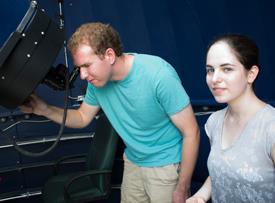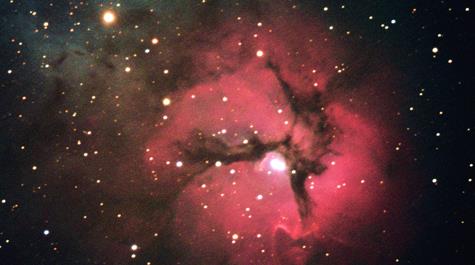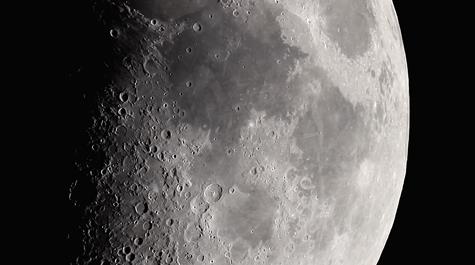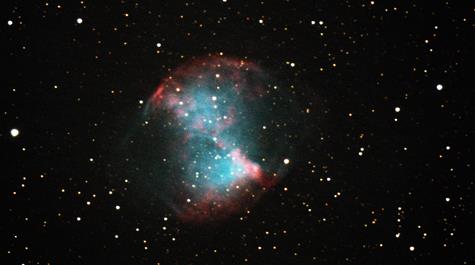From a Small observatory: Horror. Beauty. Science.
Jacob Gunnarson’s first reaction upon being handed the keys to the observatory was one of moderate horror.
Gunnarson ’17 had been working with Robert Vold, the director of William & Mary’s Thomas Harriot Observatory atop Small Hall. After some training, Vold mentioned that he was due to retire, and then asked Gunnarson — a sophomore at the time — if he was confident enough to use the observatory on his own.
“I was a little horrified because it’s extremely expensive and delicate machinery,” Gunnarson said. “I was very excited and more than a little bit nervous, but as I kept using it and getting more familiar with it, I got less and less intimidated by the complexity.”
Horror and intimidation gave way to confidence and competence to the degree that Gunnarson and another student, Alexandra Cramer ’18, began using the observatory to make photographs of the moon, planets and nebulae. In mid-September, the two were moving ahead on preparations to collaborate with an astronomer on a project to log asteroid impacts on the two biggest planets in our solar system.
The telescope and mount were installed in the observatory in early 2012, among the last upgrades that were part of a massive remodeling and expansion of Small Hall, the physics building which carries the name of Thomas Jefferson’s science tutor at William & Mary. The mount is computer-controlled, as are the dome and digital camera.
But even computer-controlled astronomy requires a fair amount of hands-on maintenance and plain old common sense. For instance, Gunnarson could use the computer to select a photographic filter from an extensive array installed in a turntable inside the telescope camera — if he only knew what command selected what filter.
“Since I didn’t know what those filters were, I couldn’t tell the computer to select such-and-such a filter,” he said. “So I had to unscrew this thing and get into its guts. I had to take out all these O-rings and put back all these O-rings back precisely. It was almost like surgery. I was very, very careful.”
Cramer and Gunnarson spent much of the summer in the Harriott observatory, learning the system and doing maintenance chores. One evening, the mount began beeping and Gunnarson had to adjust the counterweights that keep the instrument in balance.
“I just read the manual,” he shrugged.
 The two students began taking photographs with the observatory’s camera, getting results that impressed scientists at William & Mary and beyond.
The two students began taking photographs with the observatory’s camera, getting results that impressed scientists at William & Mary and beyond.
“It’s really amazing what they’re doing with the observatory,” said Wouter Deconinck, assistant professor of physics. “In one summer, they’ve gotten a lot of work done on that telescope and have gotten results that are definitely beyond our expectations.”
Deconinck sent one of the student’s photos to the team of the New Horizons space probe. “Jacob had taken a photo of Pluto right when New Horizons flew by Pluto. It was a great picture and they were impressed,” Deconinck said.
The photographic results were so impressive that Deconinck is working with the two students in a collaboration with astronomer Kunio Sayanagi, at Hampton University, to study asteroid strikes on Saturn and Jupiter. It’s work with real world impact — literally.
“Jupiter has a reputation of being kind of the vacuum cleaner of the solar system,” Deconinck said. He explained that the Jovian planet, with a mass more than twice that of all the other planets combined, has a gravitational eminence that attracts debris heading in from outer space. Cramer added that without Jupiter (and, to a lesser extent, the other large planets in the outer solar system), acting as shields, more sun-bound objects would find their way into the inner solar system, where Earth is.
Cramer is taking the lead on the collaboration, which will use the observatory to quantify asteroid strikes on the two large planets. Asteroids are too small and too far from Earth to make direct observation possible, she said, but a tally of asteroid strikes on Jupiter would make an excellent basis for computing a model of the total asteroid population expected to be headed our way.
Gunnarson said the group is in a kind of trial phase to see if the asteroid-impact observations are possible. The collaborators need three things to make it all work. First, they need a video camera to capture the flash or other evidence of an asteroid impact on the surface of Jupiter.
“For seeing the asteroid impacts, we use video because otherwise you’d be unlikely to snap a photo at the exact moment an asteroid hits,” Gunnarson explained. “So you take a video, which allows you to see the little flashes of light when asteroids hit.”
He added that enhancement techniques will allow a computer to take the best of video footage acquired and put them into one really good image. They have recently received approval for funds to buy the camera. Once the video camera is installed, Cramer and Gunnarson have to wait for proper conditions for observation. All the collaborators acknowledge that hot, humid Williamsburg is not an astronomer’s dream venue, but Deconinck and Gunnarson both say the light pollution is not too bad. Gunnarson says his personal telescope can’t get much use when he’s at home in the urbs of northern Virginia. “And I’m from Belgium,” Deconinck said, “possibly the most light-polluted place on earth.”
For Williamsburg astronomers, the problem is the changeability of the weather. “You’ll be up here on a perfectly clear night,” Gunnarson said, “and then you’ll see a flash on the inside of the dome. You look out of the shutter and there is a big storm cloud rolling in.”
In addition to a clear night, Cramer said that it’s helpful for the object to be studied be in an optimum location. “You want to see that it’s high up in the sky, because there is less atmosphere,” she explained.
The third requirement, and the trickiest one, is time. Their video observations of Jupiter will take six to eight hours each. It becomes tricky because of the construction of the observatory.
“Right now we have a problem getting out of the observatory once it starts observing,” Cramer said. “Depending on which direction the telescope is aimed at, you can’t open the observatory door.”
The hemispherical dome rotates on the stationary base of the observatory. Cramer explained that access requires the shutter in the observatory dome to be aligned with the bottom of the doorway, in the base of the observatory. Unless the planetary alignments are perfect, the shutter and the door are not — and anyone inside the observatory is inside the observatory for the duration of the observation.
“There is a way to operate this thing remotely,” Gunnarson said, “but…” He shakes his head, leaving the sentence unfinished.
“At this point in time,” Cramer said, "we’re thinking we’ll just stay in.”
The Physics Department plans to expand the use of the 14-inch Meade telescope in the Thomas Harriot Observatory. Dayle Hancock, director of the department’s teaching laboratories and Professor Keith A. Griffioen note that demand for undergraduate research projects in astrophysics is growing, and the department plans to increase the use of the observatory by adding the capability of transmitting real-time images from the CCD camera attached to the Meade telescope into classrooms in Small Hall.
“This will allow us to use the telescope for astronomy observations that are beyond the current capability of our laboratory courses,” Hancock said. “We will also be able to hold special public events for observations of current interest such as lunar eclipses, planet transits, general star-gazing and solar activity.”
 Skip to main content
Skip to main content



